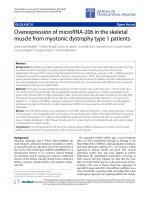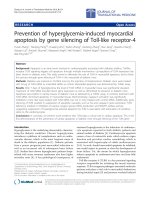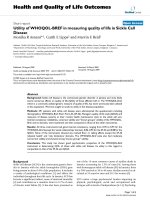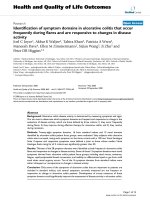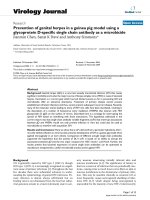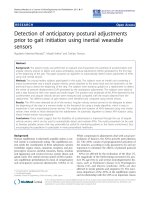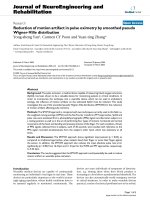báo cáo hóa học:" Prevention of genital herpes in a guinea pig model using a glycoprotein D-specific single chain antibody as a microbicide" pdf
Bạn đang xem bản rút gọn của tài liệu. Xem và tải ngay bản đầy đủ của tài liệu tại đây (597.83 KB, 10 trang )
BioMed Central
Page 1 of 10
(page number not for citation purposes)
Virology Journal
Open Access
Research
Prevention of genital herpes in a guinea pig model using a
glycoprotein D-specific single chain antibody as a microbicide
Jianmin Chen, Sanat K Davé and Anthony Simmons*
Address: University of Texas Medical Branch, Galveston, Texas, USA
Email: Jianmin Chen - ; Sanat K Davé - ; Anthony Simmons* -
* Corresponding author
Abstract
Background: Genital herpes (GH) is a recurrent sexually transmitted infection (STI) that causes
significant morbidity and is also the major source of herpes simplex virus (HSV) in cases of neonatal
herpes. Vaccination is a current goal which has had limited success so far in preventing GH and
microbicides offer an attractive alternative. Treatment of primary disease cannot prevent
establishment of latent infections and thus, cannot prevent subsequent recurrent disease. Recently,
many of the molecular events leading to entry of HSV into cells have been elucidated, resulting in
the description of a number of herpesvirus entry mediators (HVEMs) that interact with HSV
glycoprotein D (gD) on the surface of virions. Described here is a strategy for interrupting the
spread of HSV based on interfering with these interactions. The hypothesis addressed in the
current report was that single chain antibody variable fragments (scFv) that interrupt associations
between gD and HVEMs would not only prevent infection in vitro but could also be used as
microbicides to interfere with acquisition GH.
Results and Conclusions: Here we show that a scFv derived from a particular hybridoma, DL11,
not only inhibits infection in vitro but also prevents development of GH in a guinea pig model when
applied intravaginally in an inert vehicle. Comparison of different anti-gD single chain antibodies
supported the hypothesis that the activity of DL11-scFv is based on its ability to disrupt the
associations between gD and the two major receptors for HSV, nectin-1 and HveA. Further, the
results predict that bacterial expression of active single chain antibodies can be optimized to
manufacture inexpensively a useful microbicidal product active against HSV.
Background
GH is generally caused by HSV type 2 (HSV-2), though
HSV type 1 (HSV-1) is increasingly recognized as a signif-
icant cause of primary infections [1]. Throughout the last
few decades there were substantial advances in under-
standing the epidemiology of genital HSV infections. Pri-
mary infection is almost always self-limited but on
healing virus is not eliminated from the host but rather,
viral genomes remain in a latent (dormant) state in sen-
sory neurons innervating initially infected skin and
mucous membranes [2,3]. The significance of latency is
that it is a reservoir of infection that can periodically reac-
tivate, causing virus to travel down nerve fibers to skin or
mucous membranes in the dermatome of primary infec-
tion. This may be manifest clinically as recurrent GH or
more frequently, causes unrecognized shedding of infec-
tious HSV [4-7] which despite being unrecognized is
responsible for the majority of new HSV-2 infections [8].
Published: 23 November 2004
Virology Journal 2004, 1:11 doi:10.1186/1743-422X-1-11
Received: 11 November 2004
Accepted: 23 November 2004
This article is available from: />© 2004 Chen et al; licensee BioMed Central Ltd.
This is an Open Access article distributed under the terms of the Creative Commons Attribution License ( />),
which permits unrestricted use, distribution, and reproduction in any medium, provided the original work is properly cited.
Virology Journal 2004, 1:11 />Page 2 of 10
(page number not for citation purposes)
The epidemiology is further complicated by the fact that
many primary infections are asymptomatic or unrecog-
nized, which has the important implication that the first
clinical presentation of GH, often referred to as the initial
episode, may be caused by a recurrence of a prior asymp-
tomatic primary infection [9].
In the latter half of the 20
th
century, there were great
strides in antiviral therapy for GH but unfortunately, treat-
ing primary disease does not prevent establishment of
infection [10] and thus, cannot prevent subsequent recur-
rent disease. Barrier contraception provides some protec-
tion but its efficacy remains unclear [11] owing to the
complex nature of HSV pathogenesis, in which virus is
shed frequently and asymptomatically from multiple sites
below the waist [5]. Hence condoms are not as effective at
preventing transmission of GH as they are for other sexu-
ally transmitted infections. Vaccination is a current goal
which has had limited success to date. A recent trial of a
glycoprotein D-based sub-unit vaccine protected only
double (HSV-1 and 2) seronegative women but not men
[12]. Further, protection was mainly measured by preven-
tion of primary disease rather than infection. It is known
that treating primary disease does not prevent establish-
ment of latency and consequently, the long term efficacy
of this vaccine against subsequent recurrences remains
unknown.
Thus, the number of strategies for preventing sexual trans-
mission of GH is limited. Recently, there has been consid-
erable interest in topical microbicides as a potentially
attractive alternative to vaccination for prevention of sex-
ually transmitted infections, including GH [13]. Women
are able to control the use of vaginal microbicides and sev-
eral products are currently being used or tested, including
acid buffers and sulphated polymer-based inhibitors or
surfactants [14] like nonoxynol-9 (N-9) [13]. N-9 has
been used as a spermicide for 30 years and was thought to
provide some protection against gonorrhea and chlamy-
dia, a view was recently proven to be erroneous [14]. A
major factor limiting the efficacy and long-term viability
of N-9 and similar chemical compounds as topical agents
is their irritant effects on the vaginal epithelium [15]. Fur-
ther, recent data suggest that N-9, contrary to prior belief,
is not effective at protecting against HIV but rather it was
shown to increase rather than decrease the risk of acquir-
ing HIV in some populations studied, particularly women
at high risk of infection [14].
An evolving strategy that may be useful for preventing spe-
cific sexually transmitted viral infections is blocking of
virus entry into cells or subsequent inhibition cell-to-cell
spread. Many of the molecular events leading to entry of
HSV into cells have now been unraveled, resulting in the
description of two prominent cell-surface herpesvirus
entry mediators (Hve-A and nectin-1, also known as Hve-
C) that interact with HSV glycoprotein D (gD) on the sur-
face of virions [16-20]. In a recent study [21], nectin-1 was
shown to be expressed in the vaginal epithelium of
humans throughout the estrous cycle. In contrast, in mice
nectin-1 was expressed in vaginal epithelium only during
the stage of estrous at which they are susceptible to HSV.
Using a mouse model of GH, pre-incubation of HSV-2
with soluble recombinant nectin-1 was shown to block
entry of virus through vaginal mucosa [21], suggesting the
importance of nectin-1 in mediating entry of HSV into the
female genital tract. Hve-A and nectin bind to conforma-
tionally overlapping regions of gD and we were able
exploit this information together with the results of prior
studies that had mapped the sites on gD recognized by a
panel of monoclonal antibodies [22-26]. Antibody DL11
was of particular interest because it binds to an epitope on
gD that blocks the interactions between gD and both Hve-
Panel A: Hypothetical model illustrating the antigenic struc-ture of gD and demonstrating the clustering of antigenic sites into seven groups, as defined by locations of amino acids bound by various monoclonal antibodiesFigure 1
Panel A: Hypothetical model illustrating the antigenic struc-
ture of gD and demonstrating the clustering of antigenic sites
into seven groups, as defined by locations of amino acids
bound by various monoclonal antibodies. Disulphide bonds
location defined by braces. Diagram adapted with permission
from Nicola et al, 1998 [22]. Of particular relevance to this
study are the locations of sites VII (amino acid residues 11–
19), which is bound by antibody 1D3, and site Ib, a discontin-
uous epitope that includes residues 222 to 252 that is bound
by antibody DL11. Panel B: Diagram showing interface
between N-terminal amino acids of gD and HveA and the
approximate residues (blue) bound by monoclonal antibody
1D3 and, by inference, 1D3 scFv (adapted with permission
from Connolly et al, 2003 [19].
1A 1B
VII
N
1
Ib
369
Virology Journal 2004, 1:11 />Page 3 of 10
(page number not for citation purposes)
A and nectin-1 [19] (figure 1). We show here that a single
chain antibody variable fragment (scFv) constructed from
DL11 neutralizes HSV infection in vitro, inhibits cell-to-
cell spread of virus and can be used to prevent infection in
a guinea pig model of GH.
Results
Construction and expression of single chain antibodies
against gD
Four from the panel of anti-HSV gD hybridomas available
were selected for scFv construction based on the known
locations of their epitopes [22] (summarized in figure 1)
and knowledge about the neutralization properties of the
antibodies produced by them. Of particular note are the
properties of DL11, which neutralizes both HSV-1 and
HSV-2 in the absence of complement and antibody bind-
ing to its conformational epitope is known to disrupt the
interactions of gD both with Hve-A and nectin-1. Also
1D3 binds to a group VII neutralizing epitope that directly
Table 1: Degenerate PCR primers used for amplification of V
L
(kappa) and V
H
(gamma).
Nomenclature Primer sequences used for PCR reactions
Signal sequence/framework primers
Kappa 1 GGTGATATCGTGATRACMCARGATGAACTCTC
Kappa 2 GGTGATATCWTGMTGACCCAAWCTCCACTCTC
Kappa 3 GGTGATATCGTKCTCACYCARTCTCCAGCAAT
Kappa 4 CTGWTGTTCTGGATTCCTG
Kappa 5 GTGCTCTGGATTCGGGAA
Kappa 6 TCAGCTTCYTGCTAATCAGTG
Kappa 7 TGGGTATCTGGTRCSTGTG
Kappa 8 GTTTCMAGGTRCCAGATGT
Kappa 9 TGTTTTCAAGGTRCCAGATGT
Kappa 10 CTSTGGTTGTCTGGTGTTGA
Kappa 11 TGCTKCKCTGGGTTCCAG
C region kappa primer TGGTGGGAAGATGGA
Signal sequence/framework primers
Gamma 1 GAGGTGAAGCTGCAGGAGTCAGGACCTAGCCTGGTG
Gamma 2 AGGTVMAACTGCAGVAGTCWGG
Gamma 3 AGGTVVAGCTGCAGVAGTCWGG
Gamma 4 ACTGCAGGTRTCCACTCC
Gamma 5 RCTACAGGTGTCCACTCC
Gamma 6 GCYACAGMTGTCCACTCC
Gamma 7 ACTGCAGGTGTCCTCTCT
Gamma 8 RCTRCAGGYGTCCACTCT
Gamma 9 CCAAGCTGTGTCCTRTCC
Gamma 10 TGTTGACAGYCVTT CCKGGT
Gamma 11 TAYTTTAAAARGTGTCMAGTGT
Gamma 12 CTYTTAAAAGGKGTCCAGWG
Gamma 13 CYTTTAMATGGTATCCAGTGT
Gamma 14 ATGGCAGCWGCYCAAAG
Gamma 15 CTTTTAAAAGWTGTCCAGKGT
Gamma 16 CTTCCTGATGGCAGTGGTT
C region gamma primer TAACCCTTGACCAGGCATCC
Key to degenerate nucleotides: R = A+G; M = A+C; W = A+T; K = G+T; S = G+C; Y = C+T; H = A+T+C; B = G+T+C; D = G+A+T; N =
A+C+G+T; V = G+A+C
Panel A: Structure of an scFv cassette spliced using a (Gly
4
Ser)
3
hingeFigure 2
Panel A: Structure of an scFv cassette spliced using a
(Gly
4
Ser)
3
hinge. Panel B. Alternative glycine codons were
used in the overlapping region of the hinge to avoid produc-
tion of completely overlapping regions, thereby generating a
sub-optimal (Gly
4
Ser)
2
hinge.
A.
B.
V
L
V
H
V
L
V
L
V
H
V
H
N
V
L
V
H
(Hinge)
(Gly
4
Ser)
3
COOH
Virology Journal 2004, 1:11 />Page 4 of 10
(page number not for citation purposes)
interferes with the interface between gD and HveA (figure
1B). A fifth scFv cassette, against carcinoembryonic anti-
gen (CEA) was excised from a plasmid encoding an anti-
tumor chimeric T-cell receptor, kindly provided by Hin-
rich Abken (Cologne University, Germany). For produc-
tion of cDNAs, individual V
L
and V
H
regions from each
hybridoma were reverse transcribed using primers near
the V
H
-C
H
and V
L
-C
L
junctions. For PCR cloning these
primers were paired with a panel of degenerate primers
derived from V
H
or V
L
signal sequences (Table 1) that were
able to amplify all hybridoma heavy and light chains
tested so far (14/14) irrespective of antibody class or sub-
class (data not shown). PCR products were sequenced
directly to facilitate design of new primer sets allowing, on
re-amplification of hybridoma cDNAs, elimination of
degenerate primer sequences introduced in the first reac-
tion and introduction of 2/3 of a 15 amino acid hinge
region comprising three repeats of four glycine and one
serine residues (Figure 2). V
L
and V
H
are not covalently
linked in nature but flexible hinges of this design and
length were shown previously [27] to allow reconstruc-
tion of antibody binding sites when V
L
and V
H
are linked
end-to-end (figures 3, 4). Finally, the PCR products con-
taining the overlapping hinge regions were ligated, PCR
amplified and the resultant scFv cassette was TA cloned
into pCR2.1TOPO. To generate the desired single chain
antibodies, the cassettes were subcloned into the bacterial
Single plain view of a 3-D model of DL11 scFv, showing its predicted structureFigure 3
Single plain view of a 3-D model of DL11 scFv, showing its
predicted structure. Panel A: Strand view, colored by
group, demonstrates relative orientation of the kappa (top)
and gamma (bottom) chains, which shows the positions of
residues to which the (Gly
4
Ser)
3
hinge is attached. Panel B:
Wireframe image illustrating hinge attachment sites on one
side of the molecule (linked by dashed line) and clustering on
the opposite side (inside the circle) of the complementary
determining regions (CDRs) predicted by the Kabat antibody
database. The clustering of CDRs suggests correct conforma-
tion of the molecule with formation of an antigen binding
site.
Hinge
CDR
cluster
Hinge
B
A
Western blot demonstrating expression of DL11 scFv by E, ColiFigure 4
Western blot demonstrating expression of DL11 scFv by E,
Coli. BL21 cells were transfected with p-TOPO10 containing
the scFv cassette. Bacterial lysates were purified using a
nickel chelation column and the reaction with anti-V5 of total
lysates and various fractions from the column are shown.
Lane 1, unpurified total bacterial lysate; lane 2, nickel column
flow through; lanes 3 and 4, saline washes; lane 6, eluate from
Ni beads; lane 7, bacterial supernatant; lane 8, scFv remaining
on nickel column after elution; lane 9: supernatant from un-
induced bacteria.
34kd
1 2 3 4 5 6 7 8 9
Virology Journal 2004, 1:11 />Page 5 of 10
(page number not for citation purposes)
expression vector pET101-D. An antibody modeling algo-
rithm, verified by the locations of the complementary
determining regions, was used to predict the 3-D struc-
tures of all four of the anti-gD single chain antibodies. The
results were consistent with reconstitution of the original
antigen binding sites (e.g. figure 3, DL11; others not
shown).
Bacterial expression and extraction of anti-gD single chain
antibodies
The single chain antibodies were expressed in E. Coli
strain BL21 using pET101-D (Invitrogen), which attaches
hexa-His and V5 tags to expressed proteins for their isola-
tion and identification. Bacteria were induced with IPTG,
centrifuged and the supernatants tested for the presence of
scFvs by western blotting using anti-His antibody (figure
4). Bacterial pellets were sonicated in phosphate buffered
saline to release inclusion bodies and proteins were sol-
ubulized by addition of 6 M guanidine (BL21). Nickel
bead chelation was used to extract the His-tagged protein.
Western blots of eluates from nickel beads (e.g. DL11 scFv
from DL21; Fig. 4, lanes 6 and 7) identified scFvs that
were released by this procedure. They were generally iso-
lated at concentrations of 500–1000 µg/ml from BL21.
Re-folding and intra-chain disulphide bond formation
were maximized by gradually reducing guanidine concen-
tration by step-wise dialysis from 6 M initially to 3 M, then
2 M, 1 M, 0.5 M and finally 0 M, with addition of L-
arginine and oxidized glutathione (GSSG) in final two
steps [28]. The ability of the single chain antibodies pro-
duced in this way to bind their target antigen was tested by
determining their reaction with plastic bound gD by
ELISA. Binding ratios were calculated in relation to the
background binding of CEA scFv (e.g. DL11-based scFv;
figure 5)
Selected anti-gD single chain antibodies neutralize HSV in
vitro
The hypothesis that selected single chain antibodies can
block infection of cells in vitro by reacting with an epitope
that disrupts the interface between gD and HVEMs was
tested by comparing the activities of the various bacteri-
ally expressed anti-gD scFv in a Vero cell-based HSV-1
plaque reduction assay. A scFv directed against an epitope
on carcinoembryonic antigen was included as an unre-
lated control. The results showed that pre-incubation of
virus with DL11 and 1D3 scFvs inhibited plaque forma-
tion with decreasing efficiency. DL6 scFv showed minimal
but reproducible activity (data not shown), whereas the
other scFvs tested (DL2 and CEA) had no plaque reducing
capability at all (figure 6). Against HSV-2, only DL11
showed neutralizing activity in a similar plaque reduction
assay (data not shown), confirming the type common
nature of its epitope. In addition to inhibition of plaque
formation, pre-incubating HSV-2 with 100 µg/ml DL11
caused an 80% reduction in plaque numbers and a ~50%
reduction (figure 7) in the size of plaques (0.95 ± 0.3 mm
with DL11scFv vs. 1.9 ± 0.4 mm without, respectively).
The same was true for HSV-1 and DL11 (not shown). It
was concluded that DL11scFv could not only block infec-
Binding of scFv to plastic bound gDFigure 5
Binding of scFv to plastic bound gD. Binding ratios of DL11
scFv to gD compared with an irrelevant (CEA) scFv at the
same protein concentrations.
Specific reduction of HSV-2 plaque numbers by incubation of virus with anti-gD scFvFigure 6
Specific reduction of HSV-2 plaque numbers by incubation of
virus with anti-gD scFv. Vero cells were pre-incubated with
approximately 120 PFU HSV-2, strain G with single chain
antibodies generated from hybridomas D11 (¦), 1D3 (?),
DL2(?) and an irrelevant CEA-specific construct (?).
0
1
2
3
4
5
6
7
12481632641282565121024
Dilution
DL11/CEA binding ratio
0
20
40
60
80
100
120
140
1234
Number of plaques
81.25Pg/ml 162.5Pg/ml 325Pg/ml 750Pg/ml
Concentration of scFv
Virology Journal 2004, 1:11 />Page 6 of 10
(page number not for citation purposes)
tion of cells with HSV but also was able to inhibit cell-to-
cell spread of virus.
Protection against HSV type 1 and type 2 GH by
administration of a DL11-based single chain antibody
before infection with virus
The HSV type-common and startling in vitro activities of
single chain antibodies derived from hybridoma DL11
prompted us to examine the ability of DL11scFv to protect
against vaginal HSV disease, using a well established
guinea pig model of GH [29,30]. The vehicle selected for
these preliminary studies was 1% carboxymethylcellulose
because this is an inert compound that is used for its vis-
cosity in our routine plaque assays.
A pilot experiment was done with HSV-1, in which BL21
produced DL11 and DL2 single chain antibodies (0.5 mg/
ml) were each instilled into the vaginas of guinea pigs (1
ml/animal). Approximately 20 seconds later the guinea
pigs were challenged with 5 × 10
6
PFU HSV-1, strain SC16
and monitored for development and severity of primary
disease. The result (figure 8) showed that DL11-based scFv
Reduction in plaque size in the presence of DL11 scFvFigure 7
Reduction in plaque size in the presence of DL11 scFv. Mean plaque size in absence of scFv (Panel A) was 1.9 ± 0.4 mm com-
pared with 0.95 ± 0.3 mm in presence of 100 mg/ml DL11 scFv (Panel B). Figures represent mean of 100 plaques ± standard
deviation. Bar = 1 mm.
Effect of DL11 scFv on HSV-1 genital disease in guinea pigsFigure 8
Effect of DL11 scFv on HSV-1 genital disease in guinea pigs. Panel A: Blisters of GH 5 days after instillation of HSV-1 into vaginal
vault. Several areas of ulceration with surrounding erythema are visible bilaterally (e.g. arrows); Panel B: Complete protection
against HSV-1 by prior instillation, immediately before HSV challenge, of 1 ml CMC containing DL11 scFv (500 µg/ml).
A. No scFv B. 100
P
g/ml DL11 scFv
——
—
—
A
B
Virology Journal 2004, 1:11 />Page 7 of 10
(page number not for citation purposes)
completely protected the animal from lesion develop-
ment whereas DL2-based scFv appeared to have, as
expected, no effect.
Next a more ambitious test of microbicidal activity was
attempted, using HSV-2 rather than HSV-1 and a longer
interval (20 minutes) between scFv instillation and chal-
lenge (Table 2). Two groups of 20 guinea pigs were each
administered either DL11 or DL2 (control) scFv (1 ml/
guinea pig). All animals were challenged with 10
6
PFU of
HSV-2, strain G and monitored daily as before. All except
one animal were completely protected by DL11 scFv
compared with DL2 scFv, all of which developed moder-
ate to severe disease, scored as described in methods (p =
<0.0001; Mann Whitney test).
Discussion
In practice, the rapidity of isolation and cloning of scFv
into a bacterial expression vector (approximately one
week) by the procedure described here allowed
expeditious activity assessments to be made for the differ-
ent constructs. Bacterial protein expression systems are
widely used for the production of recombinant proteins
and problems are often encountered with disulphide
bond formation. Whilst there are no covalent bonds
between heavy and light chain sequences in immu-
noglobulin hypervariable domains, intra-chain disul-
phide bonds can, to varying degrees among different
antibodies, influence conformation of the antigen
binding site [31]. Thus, failure to form intra-chain
disulphide bonds has the potential to disrupt antigen
binding and could also detrimentally affect stability of the
molecule. For this reason, a previously reported method
[28] was adapted to promote formation of intra-chain
disulphide bonds in vitro, using protein extracted from
bacterial inclusion bodies. After isolation of inclusion
bodies by sonication of bacteria, proteins were sol-
ubulized with 6 M guanidine hydrochloride, the concen-
tration of which was gradually reduced to zero by a
stepwise daily dialysis routine. In all cases we tried, this
procedure generated soluble hexa-His tagged single chain
antibody fragments, which have an approximate
molecular weight of 34 kD, at concentrations of approxi-
mately 750 – 1000 µg/ml. Precipitation of proteins in the
final dialysis step tended to occur above concentrations of
1000 µg/ml and was prevented by careful monitoring of
the sample volume to ensure concentrations stayed below
this critical threshold.
Entry of HSV into cells is known to be mediated through
interactions between gD and 3-O-sulfated heparan and
one or more specific entry mediators, HveA, nectin-1 and
nectin-2 [32]. Overall, the results of plaque reduction
assays in vitro were compatible with the hypothesis that
significant interference with the binding of gD with
HVEMs can be achieved with a single chain variable
fragment selected according to the known properties of
their parent antibodies. This is the first direct evidence
that neutralization of HSV can be a property of certain
antigen binding domains alone, a corollary of which is
that no other regions of the antibody need be required to
neutralize the virus. Of the five scFvs tested in this study,
the most effective was produced from antibody DL11,
which is known to interfere with binding both to HveA
and nectin-1. Neutralization in vitro by a scFv constructed
from antibody 1D3, which binds to a site on gD that over-
laps the binding site for HveA, was significantly less effi-
cient than that seen with DL11 scFv, presumably because,
in the presence of 1D3 scFv, HSV was still able to utilize
nectin-1 as a receptor. As expected, scFvs derived from
DL2, a non-neutralizing monoclonal antibody, and a scFv
reactive against CEA showed no activity in the plaque
reduction assay. The weak activity of the construct made
from DL6 correlates with the known weak neutralizing
property of the native antibody, which is presumed to be
the result of conformational changes induced it's by its
binding to gD.
The data presented here correlate with the prior finding
that mice can be protected against HSV-2 by topical
administration of antibody [33,34] and a subsequent
report from Zeitlin et al [35] that mice were protected
against HSV-2 transmission by intravaginal administra-
tion of an IgG
2a
monoclonal anti-gD antibody and its IgA
switch variant. Here, these observations are extended in
several respects. The epitope on gD recognized by the
most effective scFv, that constructed from antibody DL11,
was defined as one that interferes with binding of gD with
two major mediators of herpesvirus entry into cells,
namely HveA and nectin-1. In this respect, attention is
drawn to the recent report of Linehan et al [21] that nec-
tin-1 is expressed in the genital tracts of mice and humans
Table 2: Prevention of GH in guinea pigs by DL11 scFv.
Pre-treatment Severity of lesions Mean lesion score (n = 20)
500 µg/ml DL2 scFv 20 minutes prior to infection 2, 2, 3, 3, 3, 3, 3, 4, 4, 4, 4, 4, 4, 4, 4, 4, 4, 4, 4, 4. 3.55 ± 0.153 *
500 µg/ml DL11 scFv 20 minutes prior to infection 0, 0, 0, 0, 0, 0, 0, 0, 0, 0, 0, 0, 0, 0, 0, 0. 0, 0, 0, 3. 0.15 ± 0.15 *
* p < 0.0001 (Mann-Whitney test)
Virology Journal 2004, 1:11 />Page 8 of 10
(page number not for citation purposes)
and soluble nectin-1 can block entry of HSV into vaginal
epithelium. These data [21] together with the unprece-
dented protection of guinea pigs by DL11scFV shown here
strongly implicate nectin-1 as a critical mediator of HSV
the entry genital epithelium and in fact it is suggested here
that nectin-1, rather than other herpesvirus entry media-
tors, likely play a dominant role in genital tract infection.
The protective activity of a scFv established with certainty
that the constant regions of anti-gD antibody molecules
are not required for protection against HSV. This finding
has the important consequence of eliminating the com-
plement binding activity of IgG, which will greatly limit
the potential for unwanted inflammatory side effects of
topically administered anti-gD preparations, an impor-
tant advantage if they are to be used clinically. The specific
nature of anti-herpes scFv and the ability to choose an
inert formulation has two potential advantages over other
microbicides. First is selected high specific activity against
HSV and second is that they are not irritating to the genital
tract. Their murine derivation is not anticipated to be a
problem with topical use, but humanization of the hyper-
variable region is possible by grafting the complementary
determining regions onto a human framework, This is an
option should their systemic use ever be considered. Of
particular interest may be the use of microbicidal gels
prior to delivery for the prevention of neonatal herpes.
The inert nature of single chain antibodies, combined
with a suitable vector, should enable their widespread use
in this context among HSV-2 seropositive mothers. These
are important considerations given the high prevalence of
GH and its frequent asymptomatic nature.
In summary, we believe that single chain antibodies
against HSV merit further study and development as top-
ical microbicides. The production of active molecules in
bacteria makes their use a feasible and relatively inexpen-
sive prospect.
Conclusions
Single chain antibodies against HSV gD could be synthe-
sized readily from several IgG secreting hybridomas using
degenerate immunoglobulin heavy and light chain
immunoglobulin primers that hybridized to regions
flanking the complementary determining regions, which
determine antigen specificity.
Two mechanisms of interference with infection were evi-
dent when DL11 scFv was examined in detail. First, the
number of plaques produced by virus could be inhibited
by up to 90% when reacted with HSV prior to infection of
Vero cells, indicating that scFv neutralized virus prior to
establishment of productive infection. This result also
suggested that nectin-1 and HveA, the binding of which
are both blocked by DL11, are the main mediators of virus
entry into Vero cells. 1D3, which interferes specifically
with the interface of gD with HveA, was effective to a lesser
extent. Second, in addition the striking ability of DL11
scFv to neutralize virus inoculums, this particular con-
struct reduced plaque size significantly, from which it was
concluded that cell-cell spread of HSV was also inhibited.
This observation could have implications for therapeutic
use of single chain antibodies in the future and may have
enhanced the performance of DL11 scFv as a microbicide
in the guinea pig model. This result was mediated by sub-
optimal scFv concentrations for virus neutralization,
implying that lower concentrations of DL11 scFv may be
required to interfere with intercellular spread of virus than
to block entry.
The finding that DL11 scFv was active for 20 minutes, the
maximum time tested, when instilled into the vaginal
vault was considered encouraging for future development
of scFv as microbicides and the observation merits further
consideration of the vehicle used. Slow release
formulations may be appropriate depending on their cost.
Overall, it appears that selected single chain antibodies
are promising candidates for interfering with binding of
gD to HVEMs and studies in a guinea pig model of GH
suggest that they may comprise a plausible strategy for
preventing transmission of GH.
Methods
Generation of scFvs
Single chain antibodies were constructed from four anti-
gD secreting hybridomas, DL11, DL6, DL2 and 1D3. An
additional scFv, directed against carcinoembryonic anti-
gen (CEA) served as an independent control. Messenger
RNAs from 5 × 10
5
- 10
6
hybridoma cells were isolated
using Trizol (Invitrogen, CA) and cDNAs were generated
by reverse transcription with Taq polymerase ('Expand
High Fidelity Taq polymerase' ; Roche, IN). RT was
primed with anti-sense oligonucleotides designed to
anneal either to mouse kappa light chain or heavy chain
constant region sequences, just downstream of the J-C
junction (table 1). Light and heavy chain hypervariable
regions (V
L
and V
H
) were amplified by priming 'sense'
PCR reaction products with panels of oligonucleotides
(OGNs) designed from Kabat database sequences to be
complementary to kappa (light chain) and gamma (heavy
chain) signal or framework sequences (table 1). In prac-
tice, pools of 11 degenerate OGN sequences were found
to be sufficient to prime 100% of kappa chain reactions
(14/14 hybridomas regardless of subclass). Similarly, a
pool of 14 degenerate OGNs successfully amplified the
gamma chains from these hybridomas. From each hybri-
doma, the resulting V
L
and V
H
cDNAs were sequenced and
new specific primers were designed each of which
included 2/3 of the fifteen amino acid (Gly
4
Ser)
3
flexible
hinge region, allowing the variable regions to be ampli-
fied and spliced together reconstituting the antigen
Virology Journal 2004, 1:11 />Page 9 of 10
(page number not for citation purposes)
binding site on reconformation (figures 2, 3). To prevent
complete overlap of the complementary hinge sequences,
which would result in the introduction of a sub-optimal
10 amino acid (Gly
4
Ser)
2
intervening segment, alternative
glycine codons were used in each component of the hinge.
Four of the scFvs were TA cloned into the bacterial expres-
sion vector pET101/D-TOPO (Invitrogen, Carlsbad, CA)
which generates hexa-His tagged proteins after expression
in vitro.
Expression of single chain antibodies in bacteria
Proteins were expressed in IPTG-induced E. Coli BL21
[DE3] (Invitrogen), released by sonication in PBS and
inclusion bodies were separated by centrifugation. Pro-
teins in inclusion bodies were solubulized with 6 M gua-
nidine HCl and purified by metal chelation. A stepwise
dialysis procedure with addition of GSSG (oxidized glu-
tathione; Sigma) and L-arginine in the final two steps was
used to assist in the formation of intra-chain disulphide
bonds in order to optimize re-conformation and stability
of the scFvs [28]. Protein concentrations were measured
using the BCA method (Pierce).
ELISA to quantify binding of scFv to gD
Microtiter plate wells were coated with soluble gD (6 µg/
ml) and then blocked with 1% skimmed milk. After
incubation with serial two-fold dilutions of scFv, binding
was detected with anti-V5, the alternative tag on the scFv,
because the recombinant gD used in the assay was, like
the single chain antibodies, tagged with hexa-His. Binding
ratios were calculated in relation to an irrelevant (CEA-
specific) scFv.
Virus growth, titration and plaque neutralization assays
HSV-1 (strain SC16) and HSV-2 (strain G) were grown
and titrated in Vero cells as described [36,37]. Titers were
determined using a standard plaque assay [38]. Cells were
grown and maintained in Dulbecco modified Eagle
medium supplemented with 10% (growth medium; GM)
or 1% (maintenance medium; MM) fetal bovine serum. A
plaque reduction assay was done in Vero cells to assess the
neutralizing capabilities of each scFv. Briefly, 100–200
plaque forming units (PFU), diluted in MM, of either
HSV-1 (strain SC16) or HSV-2 (strain G) were incubated
at room temperature for 1 hour with serial ten-fold dilu-
tions of each scFv in a total volume of 1 ml. After gentle
shaking with 3 × 10
6
Vero cells for a further 1 hour the
samples were plated in 6 cm dishes (Nunc) in a total vol-
ume of 5 mls of GM containing 2% carboxymethylcellu-
lose (CMC). Plaques were enumerated after 3 days
incubation at 37°C in a 5% CO
2
atmosphere.
Guinea pig model of GH
The microbicidal properties of scFv were tested using a
guinea pig model of GH. Female outbred Hartley guinea
pigs weighing 350–400 grams were obtained from
Charles River laboratories (Wilmington, MA). Prior to
inoculation of each guinea pig with virus, the introitus
was opened with a calcium alginate swab moistened in
physiological saline and 1 ml of 1% CMC containing
either DL2 scFv or DL11 scFv at a final concentration of
500 µg/ml, was instilled using a pipette with a plastic tip.
CMC was used as a vehicle to facilitate retention of the
scFv in the vaginal vault. At various times thereafter, ani-
mals were challenged with 10
6
PFU HSV-1 (strain SC16)
or HSV-2 (strain G). Over the ensuing two weeks lesions
were scored on a scale of 0–4 (0 = no lesion; 1 = erythema
and swelling only; 2 = small vesicles <2 mm; 3 = coales-
cent or large vesicles >2 mm; 4 = ulceration and
maceration). All experiments were done according to the
guidelines laid down in The NIH Guide for Care and Use
of Laboratory Animals and were approved by the Institu-
tional Animal Care and Use Committee.
Competing interests
The author(s) declare that they have no competing
interests.
Authors' contributions
AS conceived and coordinated the work described and
wrote the manuscript. JC was responsible for the experi-
ments described and SKD provided technical support.
Acknowledgements
Doctors Roselyn Eisenberg and Garry Cohen are thanked for providing
anti-gD hybridomas and for their helpful discussion during the project. JC
was supported by the Sealy Endowment Fund. The authors thank the Gill-
son-Longenbaugh Foundation for supporting the work described.
References
1. Jonsson MK, Wahren B: Sexually transmitted herpes simplex
viruses. Scand J Infect Dis 2004, 36:93-101.
2. Baringer JR, Swoveland P: Recovery of herpes-simplex virus
from human trigeminal ganglions. N Engl J Med 288:648-650. 3-
29-1973
3. Stevens JG, Cook ML: Latent herpes simplex virus in spinal gan-
glia of mice. Science 173:843-845. 8-27-1971
4. Stanberry L, Cunningham A, Mertz G, Mindel A, Peters B, Reitano M,
Sacks S, Wald A, Wassilew S, Woolley P: New developments in
the epidemiology, natural history and management of geni-
tal herpes. Antiviral Res 1999:421-14.
5. Wald A, Zeh J, Selke S, Warren T, Ryncarz AJ, Ashley R, Krieger JN,
Corey L: Reactivation of genital herpes simplex virus type 2
infection in asymptomatic seropositive persons. N Engl J Med
342:844-850. 3-23-2000
6. Wald A, Corey L, Cone R, Hobson A, Davis G, Zeh J: Frequent gen-
ital herpes simplex virus 2 shedding in immunocompetent
women. Effect of acyclovir treatment. J Clin Invest
99:1092-1097. 3-1-1997
7. Wald A: Herpes. Transmission and viral shedding. Dermatol Clin
1998:16795-7. xiv
8. Wald A, Zeh J, Selke S, Ashley RL, Corey L: Virologic characteris-
tics of subclinical and symptomatic genital herpes infections.
N Engl J Med 333:770-775. 9-21-1995
9. Koelle DM, Wald A: Herpes simplex virus: the importance of
asymptomatic shedding. J Antimicrob Chemother 2000,
45(Suppl):T31-8.
10. Simmons A, Field HJ: Can HSV latency be conquered by current
antiviral therapies? Sex Transm Infect 1998:741-2.
Publish with BioMed Central and every
scientist can read your work free of charge
"BioMed Central will be the most significant development for
disseminating the results of biomedical research in our lifetime."
Sir Paul Nurse, Cancer Research UK
Your research papers will be:
available free of charge to the entire biomedical community
peer reviewed and published immediately upon acceptance
cited in PubMed and archived on PubMed Central
yours — you keep the copyright
Submit your manuscript here:
/>BioMedcentral
Virology Journal 2004, 1:11 />Page 10 of 10
(page number not for citation purposes)
11. Casper C, Wald A: Condom use and the prevention of genital
herpes acquisition. Herpes 2002:910-14.
12. Stanberry LR, Spruance SL, Cunningham AL, Bernstein DI, Mindel A,
Sacks S, Tyring S, Aoki FY, Slaoui M, Denis M, Vandepapeliere P,
Dubin G: Glycoprotein-D-adjuvant vaccine to prevent genital
herpes. N Engl J Med 347:1652-1661. 11-21-2002
13. Zeitlin L, Whaley KJ: Microbicides for preventing transmission
of genital herpes. Herpes 2002:94-9.
14. WHO/CONRAD technical consultation on nonoxynol-9,
World Health Organization, Geneva, 9–10 October 2001:
summary report. Reprod Health Matters 2002, 10:175-181.
15. Wilkinson D, Tholandi M, Ramjee G, Rutherford GW: Nonoxynol-
9 spermicide for prevention of vaginally acquired HIV and
other sexually transmitted infections: systematic review and
meta-analysis of randomised controlled trials including
more than 5000 women. Lancet Infect Dis 2002, 2:613-617.
16. Carfi A, Gong H, Lou H, Willis SH, Cohen GH, Eisenberg RJ, Wiley
DC: Crystallization and preliminary diffraction studies of the
ectodomain of the envelope glycoprotein D from herpes
simplex virus 1 alone and in complex with the ectodomain of
the human receptor HveA. Acta Crystallogr D Biol Crystallogr 2002,
58:836-838.
17. Carfi A, Willis SH, Whitbeck JC, Krummenacher C, Cohen GH,
Eisenberg RJ, Wiley DC: Herpes simplex virus glycoprotein D
bound to the human receptor HveA. Mol Cell 2001, 8:169-179.
18. Ajuh PM, Browne GJ, Hawkes NA, Cohen PT, Roberts SG, Lamond
AI: Association of a protein phosphatase 1 activity with the
human factor C1 (HCF) complex. Nucleic Acids Res 28:678-686.
2-1-2000
19. Connolly SA, Landsburg DJ, Carfi A, Wiley DC, Eisenberg RJ, Cohen
GH: Structure-based analysis of the herpes simplex virus
glycoprotein D binding site present on herpesvirus entry
mediator HveA (HVEM). J Virol 2002, 76:10894-10904.
20. Krummenacher C, Nicola AV, Whitbeck JC, Lou H, Hou W, Lambris
JD, Geraghty RJ, Spear PG, Cohen GH, Eisenberg RJ: Herpes sim-
plex virus glycoprotein D can bind to poliovirus receptor-
related protein 1 or herpesvirus entry mediator, two struc-
turally unrelated mediators of virus entry. J Virol 1998,
72:7064-7074.
21. Linehan MM, Richman S, Krummenacher C, Eisenberg RJ, Cohen GH,
Iwasaki A: In vivo role of nectin-1 in entry of herpes simplex
virus type 1 (HSV-1) and HSV-2 through the vaginal mucosa.
J Virol 2004, 78:2530-2536.
22. Nicola AV, Ponce de Leon Xu R, Hou W, Whitbeck JC, Krummen-
acher C, Montgomery RI, Spear PG, Eisenberg RJ, Cohen GH: Mon-
oclonal antibodies to distinct sites on herpes simplex virus
(HSV) glycoprotein D block HSV binding to HVEM. J Virol
1998, 72:3595-3601.
23. Nicola AV, Peng C, Lou H, Cohen GH, Eisenberg RJ: Antigenic
structure of soluble herpes simplex virus (HSV) glycoprotein
D correlates with inhibition of HSV infection. J Virol 1997,
71:2940-2946.
24. Nicola AV, Willis SH, Naidoo NN, Eisenberg RJ, Cohen GH: Struc-
ture-function analysis of soluble forms of herpes simplex
virus glycoprotein D. J Virol 1996, 70:3815-3822.
25. Rux AH, Willis SH, Nicola AV, Hou W, Peng C, Lou H, Cohen GH,
Eisenberg RJ: Functional region IV of glycoprotein D from her-
pes simplex virus modulates glycoprotein binding to the her-
pesvirus entry mediator. J Virol 1998, 72:7091-7098.
26. Whitbeck JC, Peng C, Lou H, Xu R, Willis SH, Ponce de Leon Peng T,
Nicola AV, Montgomery RI, Warner MS, Soulika AM, Spruce LA,
Moore WT, Lambris JD, Spear PG, Cohen GH, Eisenberg RJ: Glyco-
protein D of herpes simplex virus (HSV) binds directly to
HVEM, a member of the tumor necrosis factor receptor
superfamily and a mediator of HSV entry. J Virol 1997,
71:6083-6093.
27. Gilliland LK, Norris NA, Marquardt H, Tsu TT, Hayden MS, Neubauer
MG, Yelton DE, Mittler RS, Ledbetter JA: Rapid and reliable clon-
ing of antibody variable regions and generation of recom-
binant single chain antibody fragments. Tissue Antigens
1996:471-20.
28. Umetsu M, Tsumoto K, Hara M, Ashish K, Goda S, Adschiri T, Kum-
agai I: How additives influence the refolding of immunoglobu-
lin-folded proteins in a stepwise dialysis system.
Spectroscopic evidence for highly efficient refolding of a sin-
gle-chain Fv fragment. J Biol Chem 278:8979-8987. 3-14-2003
29. Stanberry LR, Kern ER, Richards JT, Abbott TM, Overall JC Jr: Gen-
ital herpes in guinea pigs: pathogenesis of the primary infec-
tion and description of recurrent disease. J Infect Dis 1982,
146:397-404.
30. Stanberry LR, Kern ER, Richards JT, Overall JC Jr: Recurrent geni-
tal herpes simplex virus infection in guinea pigs. Intervirology
1985, 24:226-231.
31. Martineau P, Betton JM: In vitro folding and thermodynamic sta-
bility of an antibody fragment selected in vivo for high
expression levels in Escherichia coli cytoplasm. J Mol Biol
292:921-929. 10-1-1999
32. Spear PG, Eisenberg RJ, Cohen GH: Three classes of cell surface
receptors for alphaherpesvirus entry. Virology 275:1-8. 9-15-
2000
33. Whaley KJ, Zeitlin L, Barratt RA, Hoen TE, Cone RA: Passive
immunization of the vagina protects mice against vaginal
transmission of genital herpes infections. J Infect Dis 1994,
169:647-649.
34. Zeitlin L, Whaley KJ, Sanna PP, Moench TR, Bastidas R, De Logu A,
Williamson RA, Burton DR, Cone RA: Topically applied human
recombinant monoclonal IgG1 antibody and its Fab and
F(ab')2 fragments protect mice from vaginal transmission of
HSV-2. Virology 225:213-215. 11-1-1996
35. Zeitlin L, Castle PE, Whaley KJ, Moench TR, Cone RA: Comparison
of an anti-HSV-2 monoclonal IgG and its IgA switch variant
for topical immunoprotection of the mouse vagina. J Reprod
Immunol 1998, 40:93-101.
36. Simmons A, Nash AA: Zosteriform spread of herpes simplex
virus as a model of recrudescence and its use to investigate
the role of immune cells in prevention of recurrent disease.
J Virol 1984, 52:816-821.
37. Simmons A, Nash AA: Role of antibody in primary and recur-
rent herpes simplex virus infection. J Virol 1985, 53:944-948.
38. Russell WC: A sensitive and precise assay for herpesvirus.
Nature 1962, 195:1028-1029.


